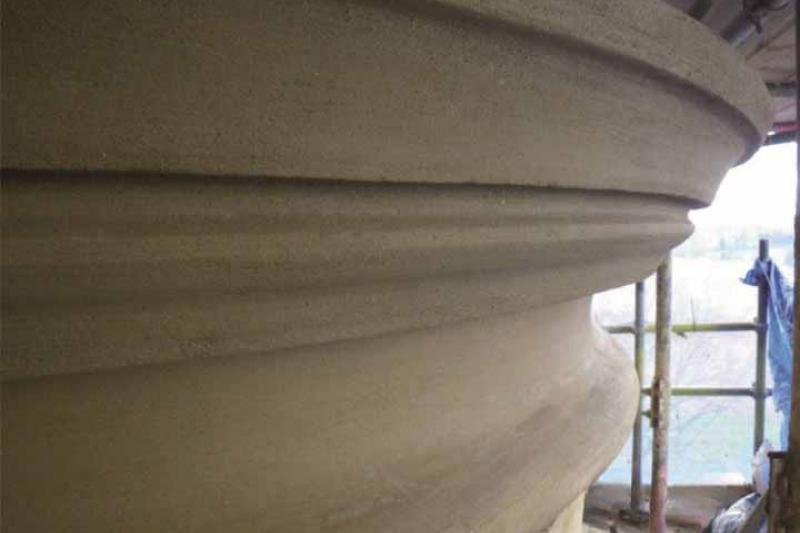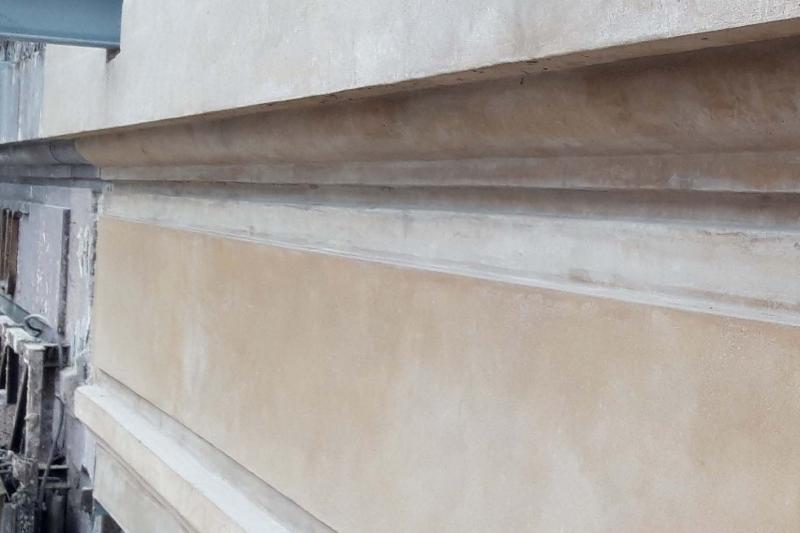Restoration & decoration
Moldings of a cornice taken from a pattern
Restoration & decoration
Works
Moldings of a cornice taken from a pattern

Molding from pattern was a technique widely used in the 19th century for facade decoration. Indeed, architectural styles of that era (neo-classical, neo-baroque, etc.) were rich in decorative elements. The casting technique using patterns for straight elements such as cornices, elbows, door and window frames, and friezes, naturally gained prominence. This technique allowed the replacement of traditional stucco (lime, Italian pozzolana, and marble powder), which was very costly for embellishing buildings.
Solution
PROMPT natural cement is used for pattern casting. In this method, a decorative PROMPT natural cement mortar is applied to the wall. Fresh mortar is projected onto the wall and immediately shaped using a pattern. This can be done in a workshop or on-site.
The thixotropy of PROMPT natural cement by Vicat, its fine texture, and adhesion enable perfect molding execution. Furthermore, its rapid setting allows for creating moldings of 2 to 15 cm thickness in multiple passes within the same half-day.
Technique
First and foremost, it's important to prepare the substrate. It should be clean, dust-free, and dampened. Then, apply a PROMPT natural cement grout using a brush. Allow this layer to stiffen but don't wait until it sets completely.
For the molding core, prepare a 1:2 mortar of sand (0-4 mm) by adding TEMPO retarder (0.25 to 0.5 capfuls per liter of PROMPT natural cement) depending on the temperature. Trowel the mortar onto the surface. The pattern should be passed multiple times to eliminate excess. Once the previous layer has lost its workability due to support suction, apply an additional layer before it begins to set.
For the finishing outer layer, prepare a 1:3 mortar of PROMPT natural cement and fine sand, adding TEMPO retarder (0 to 0.5 capfuls per liter of PROMPT natural cement) depending on the temperature. The mortar should be very plastic to facilitate extrusion. Trowel it onto the surface and wait for the appropriate time before passing the pattern (when the mortar is no longer workable, not when it starts setting). Apply another layer at this point.
For the thin outer coloring layer, prepare a 1:1 mortar of fine sand with pigment and marble powder, along with retarder: 0 to 0.5 capfuls per liter of PROMPT natural cement (depending on the temperature).
The PROMPT natural cement mortar should have a liquid consistency to properly mold the fine edges. It should be troweled or brushed onto the surface, and the pattern should be passed multiple times. Repeat this process until achieving a perfect finish.
On surfaces exposed to weather or sunlight, it's essential to protect fresh areas by placing a dampened jute cloth (without direct contact with the surface) for 1 to 2 weeks.
Fields of application
PROMPT natural cement is used for creating cast moldings with or without patterns and for sculpture decorations :
- Restoration of cast moldings, facade decorations
- Original sculptures for urban furniture
- Decorative elements for galleries or outdoor gardens
Advantages of its application

Using a mortar of PROMPT natural cement by Vicat for creating pattern-cast moldings provides :
- Rapid setting
- Time-saving due to substantial thicknesses possible
- Preservation of old substrates
- Distinct aesthetics
- High workability
Advices
With complex-shaped molds that are difficult to fill and require higher strengths for demolding, it is easier to use a natural PROMPT cement mortar with fluid workability. In this case, the use of a superplasticizer to reduce the water-to-cement ratio and provide more fluidity is necessary. Not all families of superplasticizers are effective on natural PROMPT cement; please consult with us for the selection of one. The use of a superplasticizer requires increased attention to deaeration because, in this case, vibration is minimized.
Achievements
Discover our realized projects
Product
Discover everything about PROMPT natural cement
The only cement with strengths at the end of setting, it allows for the quickest return to service. In formulations, it also acts as a powerful accelerator for all hydraulic binders (lime, Portland cement, calcium sulfoaluminate cement, calcium aluminate cement).
